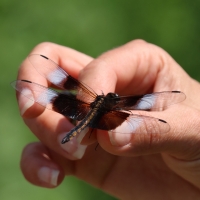The first two weeks of the internship included getting to know all the staff and interns, which allowed me to immediately feel at home with the UEC. We bonded over shared interests, summer goals, and warm summer days. By the third week, I delved straight into the science field by attending the annual Bioblitz which took place in Door County this year. I got hands-on work with other scientists in conducting bird banding (see my previous blog on using isotopes to track bird migration), snake board surveys, small mammals, odonates, spiders, beetles, and bats. The first day we trekked through cedar bogs and the second day to the scenic Pikes Peak. On the third day we journeyed to our Community Bioblitz site (a place of diverse habitat with swamps, fields, and cedar forests).
From this experience, I became contagiously interested in bird banding and migration patterns. For those who are unfamiliar, bird banding consists of setting up large mist nets (nets that are made with fine string woven together and is barely visible) to catch passing birds. We checked them every 10 minutes or so, would safely bring back the bird we found, and take its measurements. This included: species, age, brood patch size, and much more. We left them with a tiny bracelet around their ankle with a code that, if captured again, could be traced back to the exact location we previously found it. I had never been so close to such beautiful creatures before, with their curious eyes and magnificent coloration. Let´s just say it left me excited for the rest of the summer.
We were now able to use the skills we learned from the Bioblitz and bring them right to the city of Milwaukee. I felt privileged as one of the Research interns to have the chance to work at all three UEC branches. At each branch we conducted bird surveys, snake board surveys, small mammal surveys, odonate surveys, monarch surveys, and bat surveys. I could spend another hour or so talking about each individual survey, but instead I encourage you to come out next summer and see the surveys for yourself.

My favorite parts of the internship were: getting to know and work with my team, assisting with bird banding during the Bioblitz, working with ArcMap (a program that allows users to explore data within a data set, symbolize features accordingly, and create maps).
I had the privilege to work with Research and Community Science Coordinator Maggie Steinhauer, GIS and Field Data Coordinator Ethan Bott, and Manager of Research and Community Science Tim Vargo. Each member brought a unique interest whether it was odonates, technology, or birds (yes, I strategically placed those interests in order). With Ethan´s help, I learned how to upload data, make new polygons, and add finishing touches to all the maps I made. Now I feel much more confident heading to my next job.
Overall, I gained valuable skills in consistent data collection, GIS, and coordination. I learned more about Butler´s gartersnakes, monarchs, and bats, but I also learned a lot about myself.
I realized my love for making maps in GIS. I felt like an artist, cartographer, and scientist all at the same time.
I also realized how interested I was in statistical analysis. After all the data collection we did over the course of the summer, I could not help but wonder what analytic tools would be best for discovering patterns in the data. If there is one thing I love more than discovery itself, it is finding patterns in that discovery. Just like the ArcMap tool, I love piecing smaller pieces together, pulling unique parts apart, and using tools to analyze them.
Lastly, as I have always known, I love working with the community. In fact, I just read “Unscientific America” by Chris Mooney and Sheril Kirshenbaum. They discuss how in recent years, there is a disassociation between people, politics, and scientific discovery. How people have grown apart from their roots in nature and understanding of scientific evidence. This is why I loved working with the community. In a city where no one would expect natural resource surveys to occur, I had the chance to do so and involve all members of the community. Working with the community helps to close these fissures that have occurred between our civilization and nature. Honestly, they brightened my day by bringing new perspectives, personality, and interests to our surveys.
I hope this answered some questions about what the Urban Ecology Center interns do and how they contribute towards their mission to connect people with nature. I had a wonderful time in Milwaukee, and I recommend this internship for any individual searching for some research experience. While I am now off to my next adventure, I will take with me all that I learned at the UEC.
Written by: Vanessa Komada, UEC Community Science Intern





